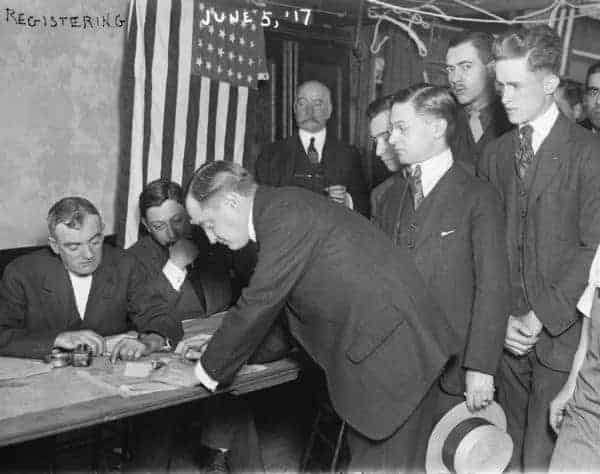The United States has had several drafts in its history. In colonial and early America, the militia system was used, and state militias would require all able-bodied men to serve. The first time the federal government used conscription was the American Civil War. However, only about 2 percent were actually drafted (another 6 percent were paid to serve by draftees).
While the Civil War is the US’s deadliest war in terms of loss of American life, it wasn’t the biggest war in terms of personnel. In the Civil war, around 3 million men served in either army (around 600,000 died). In World War I, around 4 million served in the army (around 116,000 died).

The difference is that, in the Civil War, the vast majority of soldiers volunteered for service in the armed forces and only a small number fought because of the draft. World War I, 2.8 million soldiers were drafted, while only around 2 million served as volunteers.
The United States’ participation in World War I was very controversial. While there were naval attacks on US vessels by German U-boats, it was hard for the American people to feel obligated to fight in Europe’s war. It became, for many people a situation of “why is it my problem?”

In 1917, Woodrow Wilson began preparing the US for entry into the Great War. However, only 73,000 people volunteered to join the army when the goal was 1 million.
This is where the Selective Service Act comes in. The SSA authorized the government to draft a national army using compulsory enlistment. On May 18, 1917 the Selective Service Act was put into effect by Congress. As an example of how desperate the Government was to build an army, the whole SSA bill passed through Congress between April 27 and May 18, less than a month.
The SSA required that all men between the ages of 21 and 30 to register for service in the military. By the end of 1917 more than 10 million men had registered.
Unlike the draft for the Civil War, if a person was drafted, they had to join the military, there was no way to buy your way out of it or pay someone else to join for you. The SSA stated: “No person liable to military service shall hereafter be permitted or allowed to furnish a substitute for such service; nor shall any substitute be received, enlisted, or enrolled in the military service of the United States.”
After the draft was put into place, it took more than a year for the majority of the drafted troops to be transported and trained. The first drafted troops went to Europe in June of 1917, but the majority of the new draftees wouldn’t see action until 1918.
By the end of the war in November of 1918, almost 24 million men had registered under the SSA. The SSA would fall out of use after the war ended, but would be brought back in a slightly different form beginning in 1940 when it looked to be almost inevitable that the US would play some role in World War II.

